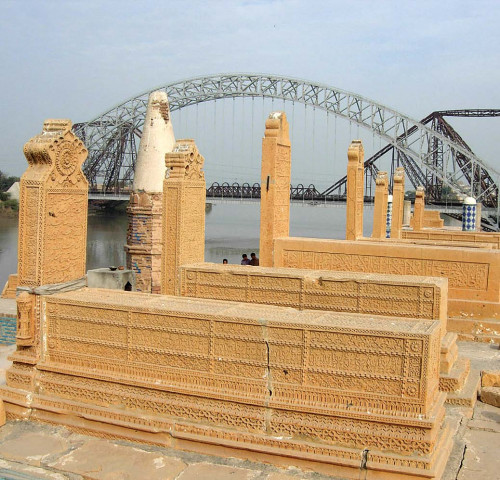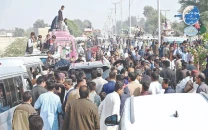Satiyan jo Asthan: Ailing women flock to Rohri’s Seven Sisters
Visitors believe that praying at the site heals many illnesses.

Ghulam Rahim Buriro does not know what ails his wife but he does know that praying at the Satiyan jo Asthan (abode of the Seven Sisters) will cure her.
Many stories and myths shroud the graves at the Satiyan jo Asthan, which is located on the left bank of River Indus in Rohri right next to Sukkur.
Legend has it that seven women, who came with the convoy of Islamist hero Mohammad Bin Qasim, chose this hilly area as their home. Others claim that the women came even before the conqueror set foot here.
Raja Dahir, the Hindu ruler at that time, set his unholy sights on the women, who were unmarried and scared about protecting their honour. They prayed to God to save them and, as the tale goes, were sucked into the very earth where they were kneeled in prayer. Today, the site is marked by a cave-like passage. On top of this cave are several graves, seven of which are prominent and intricately carved.
The graves of the seven sisters lie are inside the cave, where neither man nor camera are allowed. Only women can visit the graves and pray there to their heart’s content. Satiyan jo Asthan is reputed for its mystical powers and women from as far as Balochistan come to visit.
Mirzadi Shambhani came with her husband Bakhshoo Shambhani from Osta Mohammad, Balochistan. She told The Express Tribune that a tumor developed in her stomach eight months ago. When someone told her about these ‘bibis’, she started visiting the graves every month. “I’m feeling much better now,” she maintained optimistically.
Yasmin, a teenager from Shikarpur, was brought here by her mother. The mother said Yasmin had been suffering from epilepsy for the last four years. Nothing the doctors said or prescribed was working so they started coming to Satiyan jo Asthan. “This is our third visit in the last two months and you can see she’s much better,” she said.
The site’s caretaker, Ghulam Mohammad, told The Express Tribune that nobody knows the actual story of the seven women. “But I’ve heard that this place gave them eternal shelter when their honour was in danger.”
Ghulam Mohammad does know, however, that scores of women come to visit this place every day. Many of these visitors have chronic illnesses and many say they get well after praying here.
Another elderly female devotee came up to the caretaker and handed him a packet of sweets and Rs100. She explained that she was from Saleh Pat. She had had a headache for eight years now.
She declined to give her name but said that she started visiting the site last year. Slowly, her pains started to subside and now she feels completely healthy.
When asked if she knew whose grave she was visiting, she replied, “Han, paak bibiyan hain” [Yes, they’re holy women].
Since only females are allowed inside, Ghulam Rahim Buriro brought his 10-year-old daughter with him. The young girl went inside the cave to pray for her mother’s health.
“I have heard that Allah answers the prayers that are asked at this place,” he said. Buriro was too poor to go to a doctor and so the family did not even know what illness his wife had. “But I’m sure she will get well soon,” he said.
Around 25 stairs lead to the top of the cave, where other graves are located. They include the final resting place of then governor of Sukkur, Bakhar Mir Abul Qasim Namkeen. According to the caretaker, the other graves belong to family members of the governor and other Syeds.
Published in The Express Tribune, April 18th, 2011.



















COMMENTS
Comments are moderated and generally will be posted if they are on-topic and not abusive.
For more information, please see our Comments FAQ